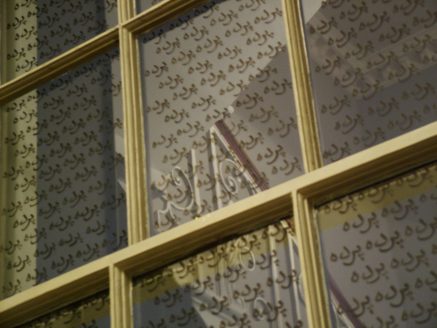

View of Exhibition showing the work of Peg Rawes to the left, Katja Grillner to the right, and Rory Hamilton in the distance, Spatial Imagination, (London: The Domo Baal Gallery, 2006). Photograph: David Cross of Cornford & Cross

Faye Carey, ‘Cum Nimis Absurdum: Perverse Imagination/Endless Solution’, Spatial Imagination, (London: The Domo Baal Gallery, 2006). Photograph: David Cross of Cornford & Cross

Brigid Mc Leer, ‘A Jealousy’, Spatial Imagination, (London: The Domo Baal Gallery, 2006). Photograph: David Cross of Cornford & Cross

Penelope Haralambidou, ‘3 John Street, 1:50’, Spatial Imagination, (London: The Domo Baal Gallery, 2006). Photograph: David Cross of Cornford & Cross

Penelope Haralambidou, ‘3 John Street, 1:50’, Spatial Imagination, (London: The Domo Baal Gallery, 2006). Photograph: David Cross of Cornford & Cross

View of Exhibition showing, from the left, the work of Penelope Haralambidou, Jonathan Hill, Nat Chard and Yeoryia Manolopoulou, Spatial Imagination, (London: The Domo Baal Gallery, 2006). Photograph: David Cross of Cornford & Cross

Jane Rendell, ‘An Embellishment: Purdah’, Spatial Imagination, (London: The Domo Baal Gallery, 2006). Photograph: David Cross of Cornford & Cross
Jane Rendell and Peg Rawes, Spatial Imagination
This paper developed out of a conversation between Peg Rawes and Jane Rendell which highlighted our theoretical, historical and practice-led interest in the role of the imagination in spatial design practices. Through our conversation we identified how the imagination is frequently misunderstood and/or overlooked in both professional and academic discussions in the spatial and architectural design disciplines that prioritize determined or predicted relations between the designer, users and products. ….
In response to these common cultural, social and historical perceptions which continue to inform understandings of design (even in the twenty-first century), we set out to develop the project in order to address each of these negative associations. In particular, we propose the following counter-arguments through which to reconstitute the spatial imagination in design as an active and critical research environment, enabling the imagination to be understood as a positive and productive constituent in the design process.
Publication Details: Jane Rendell and Peg Rawes, ‘Spatial Imagination’, Tom Inns (ed) Designing for the 21st Century (London: Gower Ashgate, 2007).













































